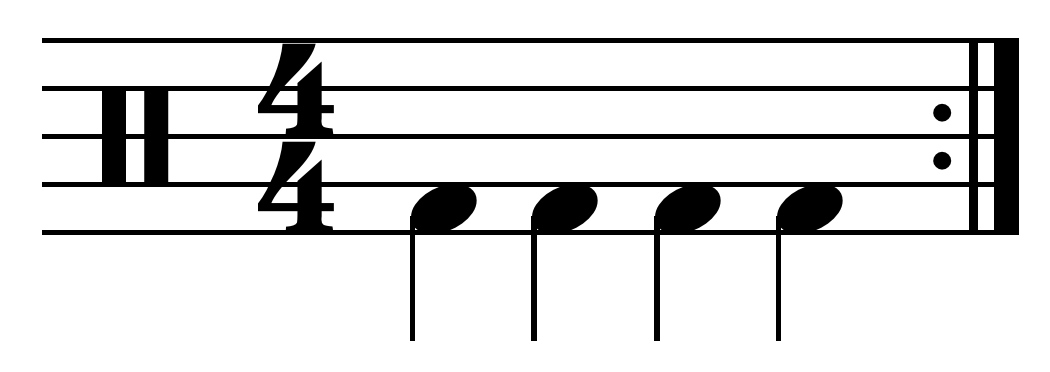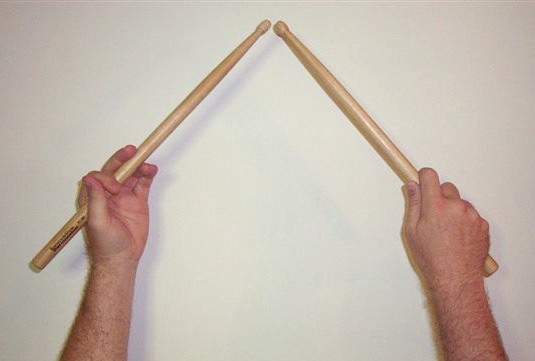|
Feed-Drum
The Feed-Drum is an imperial bass drum with a system of electronic conditioning of the skin conceived by composer Michelangelo Lupone and coproduced between CRM - Centro Ricerche Musicali, Rome and Istituto Gramma in L'Aquila. Through the principle of feed-back, the signal produced by the excitation of the skin returns to the skin in the form of acoustic pressure. The result is an infinitely sustained sound. The system controls the damping of the movement of the skin, and therefore the decay rate of the sound, and permits isolation of high frequency modes by the combined action of nodes present on the skin and the amount of feed-back input energy. The design on the skin surface is a simplified map of the oscillatory modes based on the Bessel functions. The map was limited to 13 diameters and 8 nodal circles, the latter divided into even semicircles (to the left) and odd semicircles (to the right). See also Skin-Act. File:Feed2.jpg, Map of the first 13 nodal diameters File:Feed3. ... [...More Info...] [...Related Items...] OR: [Wikipedia] [Google] [Baidu] |
Planephones
Planephones, or ''planofoni'', represent an innovative sound art creation. They are vibrating systems based on wood panels (or other materials) and different forms. Planephones diffuse the sound according to specifications which depend on the structure of the material, on the geometry of the design, on the orientation and curvature of the surfaces, and on the plastic volumes occupied. Planephones differ from conventional sound diffusion systems in that the sound acquires the timbral quality of the material employed and, in addition, by diffusing the sound homogeneously along the surface, permits designing the acoustic space. according to the architectural space. Planephones were conceived by composer Michelangelo Lupone, as art installations Installation art is an artistic genre of three-dimensional works that are often site-specific and designed to transform the perception of a space. Generally, the term is applied to interior spaces, whereas exterior interventions are often c ... [...More Info...] [...Related Items...] OR: [Wikipedia] [Google] [Baidu] |
Boosey & Hawkes
Boosey & Hawkes is a British music publisher purported to be the largest specialist classical music publisher in the world. Until 2003, it was also a major manufacturer of brass, string and woodwind musical instruments. Formed in 1930 through the merger of two well-established British music businesses, it controls the copyrights to much major 20th-century music, including works by Leonard Bernstein, Benjamin Britten, Aaron Copland, Sergei Prokofiev, and Igor Stravinsky. It also publishes many prominent contemporary composers, including John Adams, Karl Jenkins, James MacMillan, Mark-Anthony Turnage, and Steve Reich. With subsidiaries in Berlin and New York, it also sells sheet music via its online shop. History Pre-merger Boosey & Hawkes was founded in 1930 through the merger of two respected music companies, Boosey & Company and Hawkes & Son. The Boosey family was of Franco–Flemish origin. Boosey & Company traces its roots back to John Boosey, a bookseller in Lond ... [...More Info...] [...Related Items...] OR: [Wikipedia] [Google] [Baidu] |
Bass Drum
The bass drum is a large drum that produces a note of low definite or indefinite pitch. The instrument is typically cylindrical, with the drum's diameter much greater than the drum's depth, with a struck head at both ends of the cylinder. The heads may be made of calfskin or plastic and there is normally a means of adjusting the tension either by threaded taps or by strings. Bass drums are built in a variety of sizes, but size does not dictate the volume produced by the drum. The pitch and the sound can vary much with different sizes, Del Mar, Norman (1981). ''Anatomy of the Orchestra''. . but the size is also chosen based on convenience and aesthetics. Bass drums are percussion instruments and vary in size and are used in several musical genres. Three major types of bass drums can be distinguished. * The type usually seen or heard in orchestral, ensemble or concert band music is the orchestral, or concert bass drum (in Italian: gran cassa, gran tamburo). It is the largest d ... [...More Info...] [...Related Items...] OR: [Wikipedia] [Google] [Baidu] |
Feed-back
Feedback occurs when outputs of a system are routed back as inputs as part of a chain of cause-and-effect that forms a circuit or loop. The system can then be said to ''feed back'' into itself. The notion of cause-and-effect has to be handled carefully when applied to feedback systems: History Self-regulating mechanisms have existed since antiquity, and the idea of feedback had started to enter economic theory in Britain by the 18th century, but it was not at that time recognized as a universal abstraction and so did not have a name. The first ever known artificial feedback device was a float valve, for maintaining water at a constant level, invented in 270 BC in Alexandria, Egypt. This device illustrated the principle of feedback: a low water level opens the valve, the rising water then provides feedback into the system, closing the valve when the required level is reached. This then reoccurs in a circular fashion as the water level fluctuates. Centrifugal governors were ... [...More Info...] [...Related Items...] OR: [Wikipedia] [Google] [Baidu] |
Acoustic Pressure
Sound pressure or acoustic pressure is the local pressure deviation from the ambient (average or equilibrium) atmospheric pressure, caused by a sound wave. In air, sound pressure can be measured using a microphone, and in water with a hydrophone. The SI unit of sound pressure is the pascal (Pa). Mathematical definition A sound wave in a transmission medium causes a deviation (sound pressure, a ''dynamic'' pressure) in the local ambient pressure, a ''static'' pressure. Sound pressure, denoted ''p'', is defined by p_\text = p_\text + p, where * ''p''total is the total pressure, * ''p''stat is the static pressure. Sound measurements Sound intensity In a sound wave, the complementary variable to sound pressure is the particle velocity. Together, they determine the sound intensity of the wave. ''Sound intensity'', denoted I and measured in W· m−2 in SI units, is defined by \mathbf I = p \mathbf v, where * ''p'' is the sound pressure, * v is the particle velocity. Acousti ... [...More Info...] [...Related Items...] OR: [Wikipedia] [Google] [Baidu] |
Bessel Functions
Bessel functions, first defined by the mathematician Daniel Bernoulli and then generalized by Friedrich Bessel, are canonical solutions of Bessel's differential equation x^2 \frac + x \frac + \left(x^2 - \alpha^2 \right)y = 0 for an arbitrary complex number \alpha, the ''order'' of the Bessel function. Although \alpha and -\alpha produce the same differential equation, it is conventional to define different Bessel functions for these two values in such a way that the Bessel functions are mostly smooth functions of \alpha. The most important cases are when \alpha is an integer or half-integer. Bessel functions for integer \alpha are also known as cylinder functions or the cylindrical harmonics because they appear in the solution to Laplace's equation in cylindrical coordinates. Spherical Bessel functions with half-integer \alpha are obtained when the Helmholtz equation is solved in spherical coordinates. Applications of Bessel functions The Bessel function is a generalization ... [...More Info...] [...Related Items...] OR: [Wikipedia] [Google] [Baidu] |
Holophones
A parabolic loudspeaker is a loudspeaker which seeks to focus its sound in coherent plane waves either by reflecting sound output from a speaker driver to a parabolic reflector aimed at the target audience, or by arraying drivers on a parabolic surface. The resulting beam of sound travels farther, with less dissipation in air, than horn loudspeakers, and can be more focused than line array loudspeakers allowing sound to be sent to isolated audience targets.Borgerson, Bruce"Technology Showcase: Focused Loudspeaker Systems."AVInstall, November 1, 2005. Retrieved on August 25, 2009. The parabolic loudspeaker has been used for such diverse purposes as directing sound at faraway targets in performing arts centers and stadia, for industrial testing, for intimate listening at museum exhibits, and as a sonic weapon. Technology A parabolic loudspeaker can send sound farther than traditional loudspeaker designs. The focused waves of a parabolic loudspeaker tend to dissipate in air at about 3 ... [...More Info...] [...Related Items...] OR: [Wikipedia] [Google] [Baidu] |
Drums
A drum kit (also called a drum set, trap set, or simply drums) is a collection of drums, cymbals, and other auxiliary percussion instruments set up to be played by one person. The player (drummer) typically holds a pair of matching drumsticks, one in each hand, and uses their feet to operate a foot-controlled hi-hat and bass drum pedal. A standard kit may contain: * A snare drum, mounted on a stand * A bass drum, played with a beater moved by a foot-operated pedal * One or more tom-toms, including rack toms and/or floor toms * One or more cymbals, including a ride cymbal and crash cymbal * Hi-hat cymbals, a pair of cymbals that can be manipulated by a foot-operated pedal The drum kit is a part of the standard rhythm section and is used in many types of popular and traditional music styles, ranging from rock and pop to blues and jazz. __TOC__ History Early development Before the development of the drum set, drums and cymbals used in military and orchestral music sett ... [...More Info...] [...Related Items...] OR: [Wikipedia] [Google] [Baidu] |



